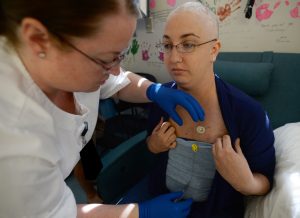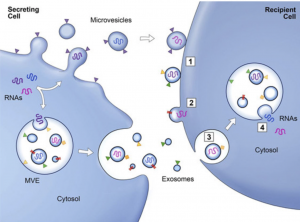The word breast does not seem scary until it is placed beside the word cancer.
Breast cancer (BC) is a disease with a morbidity rate of about 28% and a mortality rate of 15% for women worldwide. Breast cancer is the most prevalent and deadliest disease for woman from all countries, developed and developing.
To better treat and diagnose the cancer, we must understand how cancer develops and the process of tumour progression.

Retrieved from Flickr.
For starters, cancer cells are so successful because of their communication between cells to maintain viability and growth. The main way that tumours due this are using exosomes. Exosomes are a type of extracellular vesicle, and their main role is being a mediator, communicating between many different cell types within the body. Unfortunately, tumours can manipulate these vesicles and use them to their advantage for BC onset, progression and can also aide in the resistance to some treatment therapies. Specifically, exosomes that come from breast cancer cells aide in enhancement of cell proliferation, invasion, migration and chemoresistance in surrounding cells so that the tumour can expand. But according to current research, there may be a way to solve some of these issues. Understanding how exosomes work and their communication techniques allow for researchers to determine ways to manage BC exosomes and perhaps find a way to prevent further damage by these vesicles.

Exosomes transferring information from one cell to another. Retrieved from Flickr.
Although this study found many roles exosomes have, most were negative in terms of BC. For instance, exosomes allow the transfer of instruction to healthy cells that create the process of growing tumours. Additionally, they have an essential role preparing other parts of the body for tumour infestation, preparing tissue before tumour cells even arrive at the site. However, the silver lining to many of the exosome cancerous roles, is that researchers now know all the harm that they can cause with their various roles. Thus, studying them from this perspective has given a better understanding and development of therapeutic options can be constructed from this knowledge.
Seems drastic and very pessimistic, but here is a recent finding that proves it is in fact a silver lining and it is not all bad. The normal tissue that was found in metastatic niche, the area that is prepped for tumour infestation beforehand, can contain the tumour but have it be dormant, meaning that it is not harmful. This is because is exosomes secrete specific compounds given, when they target BC cells, it initiates a transition in the cell phenotype. A phenotype is a fancy word for the cells trait or characteristic. Therefore, the tumour cell remains but becomes benign.
An additional study used exosomes to deliver compounds to BC cells in the body which restores the original gene expression of the cell, successfully restoring the cell to healthy tissue. Plus, another study used exosomes to deliver therapies that prevented tumour growth. So exosomes are negative but by finding all these negative roles, we are able to counteract in a positive way to try and treat BC using their role in our favour. They are all in trials because the main concern is exosomes ability to provide chemoresistance to cells. When this happens, cells mutate and can fight treatments which makes it difficult to remove the cancer and prevent it from coming back. Current research is being done to prevent chemoresistance, but for now that is why these treatments have remained in the trial series.

Retrieved from Flickr.
Overall, although exosomes are highly negative vesicles regarding cancer cells, this knowledge can be used against tumours and can aide in treatments. There are concerns, but that is why it is in the trial stage and this new research about the exosome role only further helps development. It is hopeful that new diagnostic tools using exosomes will come out in the next couple years, although it isn’t a treatment, early detection only strengthens the survival rates for women. This creates vast potential and hope for woman in younger generations growing up, and current woman know who are at risk!
Source:
Groza, M., Zimta, A., Irimie, A., Achimas‐Cadariu, P., Cenariu, D., Stanta, G., & Berindan‐Neagoe, I. (2019). Recent advancements in the study of breast cancer exosomes as mediators of intratumoral communication. Journal Of Cellular Physiology, 235(2), 691-705. doi: 10.1002/jcp.29096

Alex
"This title was very eye catching! That is so interesting that such a ..."
Alex
"This is really interesting! The fact that crops and plants are damaged is ..."
Alex
"Well done, this article is great and the information is very captivating! Ethics ..."
Alex
"I was intrigued throughout the whole article! This is such an interesting topic, ..."
Alex
"This is such an interesting article, and very relevant!! Great job at explaining ..."
Grandpa
"Honey You Did a good job I will forward to my eye doctor "
murphymv
"This article is fascinating because it delves into the details of the research ..."
murphymv
"I agree, adding the photo helped solidify the main finding. "
murphymv
"This is a fascinating finding. I hope this innovative approach to improving transplants ..."
Sherzilla
"This is a great article! I would really love to hear how exactly ..."
Sherzilla
"It's disappointment that these treatments were not very effective but hopefully other researchers ..."
Sherzilla
"I agree with your idea that we need to shift our focus to ..."
Sherzilla
"It's amazing to see how such an everyday household product such as ..."
Lauren Kageler
"I will be interested to see what the data looks like from the ..."
Lauren Kageler
"A very interesting article that emphasizes one of the many benefits that the ..."
maricha
"Great post! I had known about the plight of Little Browns, but I ..."
Sherzilla
"I assumed cancer patients were more at risk to the virus but I ..."
Sherzilla
"Great article! It sheds light on a topic that everyone is curious about. ..."
maricha
"This article is full of really important and relevant information! I really liked ..."
maricha
"Definitely a very newsworthy article! Nice job explaining the structure of the virus ..."
maricha
"It's interesting to think that humans aren't only species dealing with the global ..."
murphymv
"This is very interesting and well explained. I am not too familiar with ..."
Lauren Kageler
"Great article! This post is sure to be a useful resource for any ..."
Lauren Kageler
"Definitely seems like an odd pairing at first, but any step forward in ..."
murphymv
"What an interesting article! As you say, height and dementia seem unrelated at ..."
murphymv
"Great article! I learned several new methods of wildlife tracking. This seems like ..."
murphymv
"Very interesting topic! You explained cascade testing and its importance very well. I ..."
Alex
"This article is really interesting! What got me hooked right away was the ..."
Sabrina
"I found this article super interesting! It’s crazy how everyday products can cause ..."
Erin Heeschen
"I love the layout of this article; it's very eyecatching! The advancements of prosthetics ..."
murphymv
"Awesome article! I like the personality in the writing. Flash Graphene not only ..."
murphymv
"Very interesting work! I don't know a whole lot about genetics, but this ..."
Cami Meckley
"I think the idea of using virtual reality technology to better help prepare ..."
Erin Heeschen
"I wonder if there's a connection between tourist season and wildfires in the ..."
Ralph berezan
"Not bad Good work "
Michelle
"This sounds like it would be a great tool for medical students! ..."